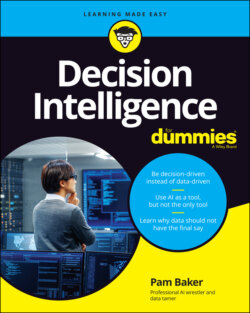Читать книгу Decision Intelligence For Dummies - Pamela Baker - Страница 46
Cryptic Patterns and Wild Guesses
ОглавлениеIN THIS CHAPTER
Seeing why data analytics are better assistants than usurpers
Leveraging humans and machines to achieve better business value
Recognizing that pattern detection can miss the big picture
Yahoo! put the first Hadoop cluster — arguably, the first truly successful distributed computing environment designed specifically for storing and analyzing huge amounts of unstructured data — into production back in 2006. It’s that date which, for most practical purposes, marks the onset of the big data gold rush and the hunt to discover unknown information buried in known data sets.
The results were largely perceived to be worth the effort and generally enlightening — even though most big data initiatives fail to this very day. Even so, the call for data driven businesses, to the chagrin of business leaders and managers everywhere, became the mantra in business and investment circles worldwide. Organizations were soon convinced that using data analytics meant the same thing as harvesting answers. The thinking was that the answers generated were perfect right out of the box and were produced by means far beyond mere human abilities. Gut instinct and human talent were summarily discounted and dismissed as little more than wild guesses. However, the reality was and is quite different, as analytics have limits, big data and AI projects have high fail rates, and business executives very often let their gut instincts override algorithm outcomes.
Fear of AI began to soar as people expected machine masters to leap from science fiction and rule the real world. But that’s a far cry from what has happened so far.
The notion that data analytics was somehow churning out answers at a record pace gave way to the broadening realization that what analytics actually was producing were insights. Humans were still needed to glean understanding and perhaps inspiration from those insights and to turn them into decisions and actions.
It turns out that machines aren’t the new masters of the human race, after all. And they don’t provide the final answers humans seek. But that’s more the fault of humans than the machines. People were so busy asking questions of the data that they forgot to look where the work was headed. Organizations often found themselves working in circles or solving problems that yielded no tangible benefits for the questioner.
What organizations really seek is not so much an answer, but rather a path to a specific destination. In this chapter, you will find out why that distinction matters and how it changes the way you make decisions.
